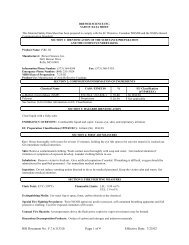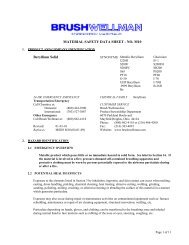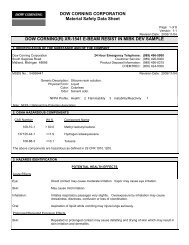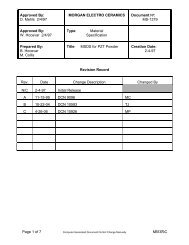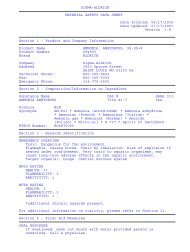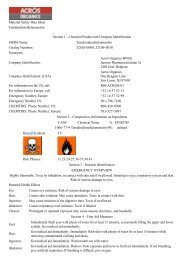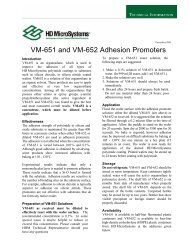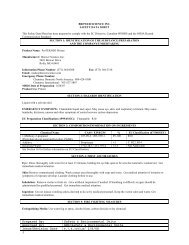Radiation tolerant sensors for the ATLAS pixel detector
Radiation tolerant sensors for the ATLAS pixel detector
Radiation tolerant sensors for the ATLAS pixel detector
You also want an ePaper? Increase the reach of your titles
YUMPU automatically turns print PDFs into web optimized ePapers that Google loves.
332<br />
R. Wunstorf / Nuclear Instruments and Methods in Physics Research A466 (2001) 327–334<br />
Fig. 5. Depletion depth measurement ofan unirradiated and an<br />
irradiated <strong>ATLAS</strong> <strong>pixel</strong> sensor.<br />
Fig. 6. Analog charge measurement across two adjacent <strong>pixel</strong><br />
cells.<br />
and <strong>the</strong> use ofoxygenated silicon. In <strong>the</strong> first<br />
prototype, <strong>the</strong> yield of<strong>the</strong> 16 times smaller single<br />
chips was much higher than that of<strong>the</strong> full size<br />
tiles. The reason <strong>for</strong> this could be randomly<br />
distributed defects, like scratches introduced during<br />
<strong>the</strong> different processing and handling steps or a<br />
particular risky design feature. The most challenging<br />
design feature is <strong>the</strong> small bias dot which<br />
requires an alignment accuracy better than 2 mm.<br />
This question was investigated with <strong>the</strong> second<br />
prototype, where three large tiles were implemented<br />
in <strong>the</strong> wafer layout with different design<br />
options of<strong>the</strong> bias dot, a small dot, a large dot,<br />
and a bias grid without integrated dots. The<br />
resulting yield statistic showed <strong>for</strong> two different<br />
vendors no yield loss due to <strong>the</strong> small dot design.<br />
There<strong>for</strong>e, this design (see Fig. 7) was taken <strong>for</strong> <strong>the</strong><br />
production, which will have <strong>the</strong> optimum charge<br />
collection.<br />
Both vendors, CiS (Erfurt) and ITC (Trento),<br />
produced halfof<strong>the</strong> second prototype wafers with<br />
oxygen diffusion of24 h at 11508C to allow a<br />
comparison in <strong>the</strong> sensor per<strong>for</strong>mance. As already<br />
shown be<strong>for</strong>e (Fig. 3) <strong>the</strong> material will be more<br />
radiation <strong>tolerant</strong> to charged hadrons. Irradiations<br />
ofoxygenated and not oxygenated second prototype<br />
<strong>sensors</strong> have been per<strong>for</strong>med up to 10 15 neq/<br />
cm 2 with 55 MeV protons at LBNL, Berkely, and<br />
with 24 GeV protons at CERN, Geneva, and are<br />
currently under investigation. The I2V characteristics<br />
show <strong>for</strong> both cases only <strong>the</strong> known increase<br />
in <strong>the</strong> bulk generation current without any<br />
indication ofbreakdown up to 1000 V. Irradiated<br />
single chips have been bump bonded to FE-chips<br />
and were successfully operated in <strong>the</strong> CERN<br />
testbeam. As expected, <strong>the</strong> oxygenated silicon<br />
shows full depletion and full charge collection at<br />
much lower bias voltages. These <strong>pixel</strong> <strong>sensors</strong> can<br />
be operated without any problems even after high<br />
irradiations and at <strong>the</strong> same time allow <strong>the</strong> direct<br />
measurement of<strong>the</strong> depletion depth (Fig. 5) and<br />
<strong>the</strong> measurement of<strong>the</strong> analog signal. There<strong>for</strong>e,<br />
<strong>the</strong> <strong>pixel</strong> <strong>sensors</strong> allow <strong>for</strong> <strong>the</strong> first time <strong>the</strong> study<br />
of<strong>the</strong> dependence of<strong>the</strong> depletion depth and <strong>the</strong><br />
charge collection from <strong>the</strong> applied voltage after<br />
different fluences, especially after type conversion.<br />
5. Production<br />
The <strong>ATLAS</strong> <strong>pixel</strong> <strong>detector</strong> will need totally<br />
more than 2000 modules <strong>for</strong> <strong>the</strong> outer two layers


